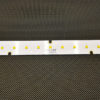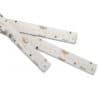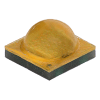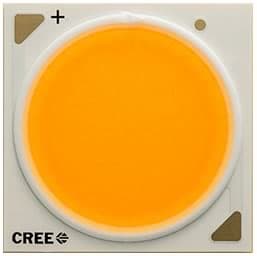Led Technology
What is a COB? Led
COB LEDs are very cost effective light sources in LED lighting business. Lets examine this light source, so what exactly is COB? First of all, the abbreviation COB means Chip-on-Board.

Cree COB topside, The yellow substance is phosphor, below the phosphor are blue led chip. When powered the blues chips excite the phosphor creating white light. Note The term LES(light emitting surface) refers to the diameter of the yellow area
In COB packages many LED chips are usually attached to substrate with non-conductive adhesive. LED chips are wire bonded together to make different LED setups. The amount of single LED chips, inside a one COB LED package, can vary from few pieces up to several hundred pieces.

Substrate is located on base material. Base material of COB LED is usually MCPCB or ceramic PCB. COBs often have blue diodes and use yellow phosphor layer to convert light to desired colour temperature. While 450nm is generally the go to led pump(chip), more recent developments have seen variations in the pump, to wavelengths like 405 and 410nm, these wavelengths when combined with custom phosphors have created COB’s with application specific markets in mind, these products are variously referred to as Crisp White, Decor, Speciality, Fidelity and typically all exhibit CRI(Colour Rendering Index) >95

Construction of an Aluminium based COB LED.
Historically there were few SMD LED packages, which would have been considered as COB packages due to their construction, the precursor were small high brightness SMD leds with more than a single per package. First COB LED packages became available and popular in LED lighting around 2007. Initially there was quite a lot doubt around COB LEDs by the market . Mainly because this package construction enabled LED manufacturers to put high power in small packages. Until then, this “high power” meant less than 10W. The paradigm of COB, required a rethink in terms of Heatsink and secondary optics/reflector designs
So there was very little experience of COB LEDs and these LEDs had a lot to prove. Current lifetime summaries now show the COB led package to be very reliable, if heat management is considered as the primary design parameter.
The efficacy of the COB for the best devices exceed 170 Lumens Per Watt, the ability to provide COBs that exceed 200 LPW is fundamental thermal dynamics, that many chips, so close together makes major efficiency gains difficult when constrained by the ability to move heat, fast away from the led chips.
When thinking about heat management, one important feature is thermal resistance. But it is worth noting, that you can’t define which COB LED is better to conduct heat just from thermal resistance value. You should actually test LEDs in your own application.

Aluminum Base COBs
Today COB LEDs are available from a few hundred lumens up to 40,000 + lumens. This means that almost every light source can be replaced with a COB LED solution. So available power go from few watts up to almost 200 watts. The most powerful COBs require excessive heat sinks because they generate a lot of heat.
COBs offer great variety due to possibility to have many different LED setups even inside one COB package as evidenced by recent product releases with dual colours for dim to warm applications. Usually LED manufacturers have different lumens packages available in same size COB, so lighting manufacturers is able to use e.g. same connectors and optics in different solutions. Also it is good to remember that usually you can under-drive or overdrive COB LEDs and those might have quite a wide driving range. This allows you to drive LEDs with very high efficacy, you can make a balanced solution or you can make economical lumens.
COB LEDs are generally used in luminaires where lamp or single spot light sources have been used. So basically COB LEDs are used in almost every kind of luminaire. Although COB LEDs are used less often in linear lights or panel lights, some solutions of that kind have been made with COBs. Luminaires which have really high luminous flux are usually made with more than one COB LED to distribute heat flux and to ease design of heat sink.
COBs offer very high luminous fluxes from small size packages and thus allow flexible design of luminaire. This gives you more freedom, when designing a luminaire. COB packages usually have excellent uniformity of light from light emitting surface, this is important e.g. if you want to avoid multiple shadow effect, which might occur with SMD based solution. It is also very easy to test COB LEDs. You only need COB LED, constant current driver and e.g. piece of aluminium, which can be used as heat sink.

LED Shadows: On the left, a shadow from a COB. On the right, a shadow from a LED with multiple light sources
We can see that COB LEDs have been very important development step in LED lighting business. This great package design has allowed designers to increase power used inside one LED package significantly. Also one good indicator of success of COBs is that today every major LED manufacturer and package maker has COB LEDs in their selection.

















